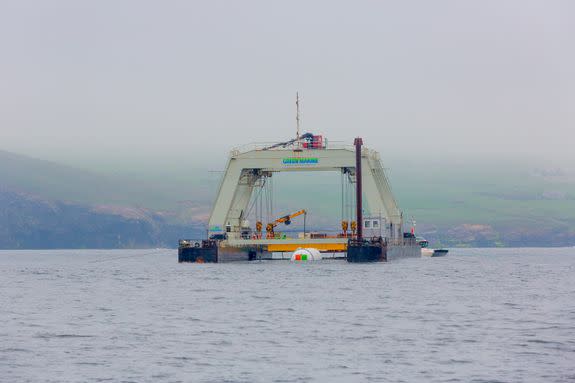Microsoft tests underwater datacenter in the Scottish sea

Off the coast of Scotland's Orkney Islands, waves crash, winds whip, and a damp fog from the sea hovers in the air nearly year round.
And now, underneath Scotland's cold, turbulent waters, a data center hums away, providing the Scottish isles' coastal communities with high speed cloud computing capabilities and internet connectivity.
SEE ALSO: Here's How Your Phone's Internet Works
On Tuesday, Microsoft announced that it had deployed the second phase of Project Natick: a "moonshot" research project to test the viability of underwater datacenters. It placed the datacenter off the coast of the Orkney Islands, which are at the northernmost tip of Scotland. Microsoft will monitor the device for the next 12 months to see how what was an idea on paper just four years ago functions in the real world.
“We know if we can put something in here and it survives, we are good for just about any place we want to go,” project manager Ben Cutler said in a statement.
A datacenter is a facility that houses connected servers. It is essentially where all of the information on the internet is physically stored. When you browse a web page, or access your account information, what you're really doing is calling up that information from a datacenter.
Project Natick's datacenters serve the same function, but they are submarine-like capsules about the size of a shipping container, as opposed to massive, energy sucking on-land structures.
Demand for datacenters is exploding with the proliferation of smartphones and A.I. Microsoft launched Project Natick to help meet that need in the future, while addressing some of the challenges facing datacenters.
Primarily, datacenters require a huge amount of energy to run. That's partially thanks to the need to keep the servers and the environment cool. An underwater datacenter addresses this challenge in two ways.
First, Microsoft placed the datacenter next to the European Marine Energy Center. The center captures energy generated by the movement of seawater through tidal turbines and wave energy converters. That renewable energy powers the datacenter — no fossil fuels required.

Image: Scott Eklund/Red Box Pictures
Second, placement under water provides a naturally cool environment. Microsoft brought on an experienced marine engineering firm for the project. It found that it could use many of the same techniques that maintain the climate of submarine — such as pipes that channel seawater around the vessel — to keep the datacenter cool, too.
The Orkney Islands project only launched after the successful completion of Project Natick's phase one. Phase one was the first ever underwater data center. That involved placing a smaller, similar vessel off the coast of California, in shallow and placid waters. This 105 day test essentially served as a proof of concept, while phase two is all about testing real world viability.
Microsoft acknowledged that it has a long way to go on the project before it can become reliably scalable. But that's the point of a moonshot. If Project Natick works, it could help millions of people in coastal communities gain access to the internet, without eating up the polluting energy resources usually necessary to power datacenters.
So to the moon we go.
WATCH: In the battle over Net Neutrality, 5G could be our salvation


 Yahoo Finance
Yahoo Finance 